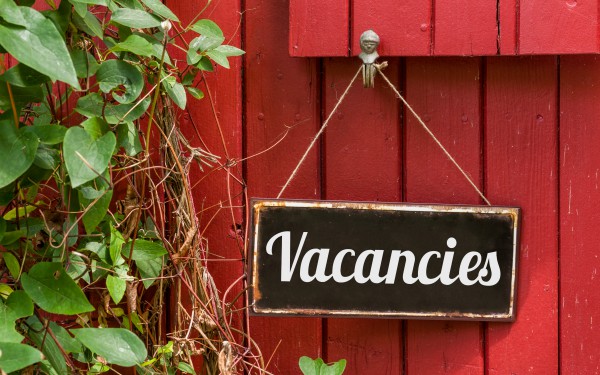
The adult social care staffing situation in England continues to deteriorate with vacancies still rising while the number of filled posts falls.
The latest monthly update from Skills for Care shows that vacancies rose from 9.4% to 9.5% between December 2021 and January, while the number of filled posts fell to 4.3% below March 2021* levels in January. This compares with a figure of 3.7% below March 2021 levels as of December.
The vacancy rate rose slightly across all types of service and is now well above the 6% seen in April 2021, among organisations that have submitted data to Skills for Care’s Adult Social Care – Workforce Data Set during the current financial year.
They remain highest in domiciliary care, at 12.7%, followed by nursing homes (9.4%) and residential homes (8.3%).
Almost one in five nursing posts unfillled
Among roles, the situation is starkest among registered nurses, for whom there is a vacancy rate of 17%, a 7.7 percentage point rise since March 2021. But there is also a staffing gap of more than one in ten among registered managers (12.6%) and care workers (11.8%).
In relation to filled posts, care worker roles have fallen faster than the average, down 5.7% since March 2021, with the situation particularly bad in nursing homes. For these services, filled care worker posts have fallen by 8.3% since March 2021 as of January, a significant deterioration since December, when the drop was 7.4%.
Skills for Care has previously described the situation of rising vacancies and falling numbers of filled posts as “a supply and demand mismatch, with employers unable to find the staff they need to meet the demand for services”.
Factors cited for the situation include pay falling behind that in other sectors, such as retail, a lack of pay progression in care work, the closing off of immigration routes into the sector post-Brexit and the impact of mandatory vaccination, in place in care homes since November 2021.
Scrapping mandatory vaccination and easing immigration
As well as providing £462.5m to councils to help providers tackle staff shortages, from October 2021 to March 2022, the government has responded to sector calls to scrap mandatory vaccination, subject to consultation, and enable overseas staff to come in to work as care workers.
Mandatory vaccination remains in force in care homes and the government previously estimated that it would cost the sector about 40,000 staff.
The relaxed immigration rules came into force this week, though employers can only make use of them if they have a skilled worker sponsorship licence and are paying at least £10.10 for the role – above the median wage for care workers in the independent sector of £9.01 as of March 2021.
The national living wage (NLW), for staff aged 23 and over, is due to go up by 6.6% in April, to £9.50 an hour. However, the government’s preferred measure of inflation – the consumer prices index (CPI) – reached 5.5% in January and the Bank of England predicts inflation will top 7% by the spring before starting to come down. This will cancel out the real-terms benefit of the NLW rise.
‘Staff are exhausted’
In response to the latest figures, the chief executive of the Homecare Association, Dr Jane Townson, said that, while care hours delivered by domiciliary agencies had increased by 15% in the past year, staffing numbers had fallen, on Skills for Care’s figures, by 4.2% since March 2021.
She added: “Homecare staff continue to demonstrate remarkable commitment to the people they support…Right now, though, many homecare workers are exhausted as the increase in hours delivered is being achieved with reducing numbers of staff.
“Members report that recruitment and retention of staff is the hardest it has ever been. Inadequate pay and terms and conditions, driven by inadequate funding from central government leading to inadequate fee rates for homecare from local authorities, are key drivers.”
Referencing the government’s white paper on adult social care, which aims to “shift away from a reliance on residential care, and offer people genuine options for drawing on outstanding care at home”, Townson said: “To turn this vision into reality, homecare needs much greater investment. Investing adequately in homecare helps to enhance quality of life, improve outcomes, take pressure off the NHS and save money for the health and care system.”
Related articles
* The story originally said that the baseline for the fall in filled posts was April 2021. It is actually March 2021. We apologise for the error.


 Bournemouth, Christchurch and Poole
Bournemouth, Christchurch and Poole  Hampshire County Council
Hampshire County Council  Lincolnshire County Council
Lincolnshire County Council  Norfolk County Council
Norfolk County Council  Northamptonshire Children’s Trust
Northamptonshire Children’s Trust  South Gloucestershire Council
South Gloucestershire Council  Wiltshire Council
Wiltshire Council  Wokingham Borough Council
Wokingham Borough Council  Children and young people with SEND are ‘valued and prioritised’ in Wiltshire, find inspectors
Children and young people with SEND are ‘valued and prioritised’ in Wiltshire, find inspectors  How specialist refugee teams benefit young people and social workers
How specialist refugee teams benefit young people and social workers  Podcast: returning to social work after becoming a first-time parent
Podcast: returning to social work after becoming a first-time parent  Podcast: would you work for an inadequate-rated service?
Podcast: would you work for an inadequate-rated service?  Family help: one local authority’s experience of the model
Family help: one local authority’s experience of the model  Workforce Insights – showcasing a selection of the sector’s top recruiters
Workforce Insights – showcasing a selection of the sector’s top recruiters 

 Facebook
Facebook X
X LinkedIn
LinkedIn Instagram
Instagram
IT appears the Government have forgotten about how urgent removing the VCOD restrictions is to prevent the social care workforce crisis from falling into more of a problem than it already is.
Staffing situations continue to get harder as the revision of VCOD still looms.